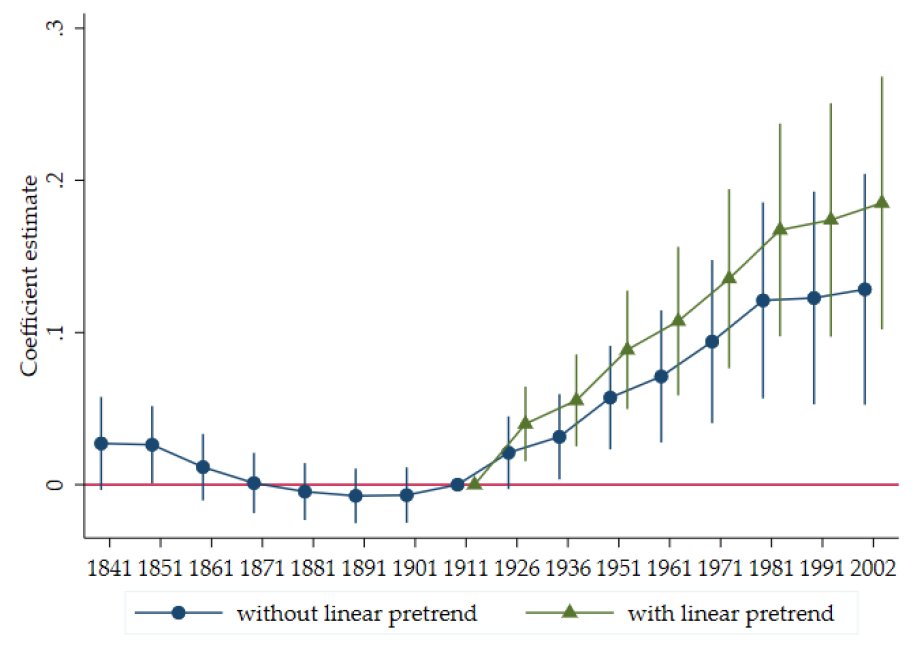
🚨What are the long-run effects of social housing? I have a piece in @thecurrency today on my latest working paper, joint with @alandebromhead, on this question - specifically how social housing can affect the spread of the population. (1/20)
#EconTwitter
https://twitter.com/thecurrency/status/1470717706173390851?s=20
#EconTwitter
(2/20) In our new paper, @alandebromhead and I examine this issue using the world's first large-scale rural public housing scheme, the Labourers Acts cottages in Ireland.
(3/20) Between 1883 and 1915 - and in particular after 1906 - large numbers of very heavily subsidized cottages were built all across rural Ireland, as part of Westminster's policy of 'constructive unionism' (aka "Killing Home Rule with kindness").
(4/20) We map these to the level of the 'rural district', of which there were 213 across the island of Ireland. These districts had on average 14,000 inhabitants and, already by the 1911 Census, 6% of their housing was LA Cottages.
(5/20) But the uptake varied hugely across the country, with uptake higher in Munster and Leinster - although once subsidies were dramatically increased in 1906, Ulster started taking part with gusto too. 

(6/20) We examine how the intensity of the 'treatment' (how many cottages a district got) affected future population growth, between 1911 and 2002. To start, we need to make sure that these weren't placed in areas that were going to grow faster anyway.
(7/20) As our pre-trends analysis shows, if anything, they were placed in districts with worse population trajectories 1841-1911. We also control for distance to Dublin, Belfast and other urban centres, latitude, longitude and a bunch of other factors including land values. 

(8/20) We find that, on average a 10% increase in the number of cottages per person increases pop growth 1911-2002 by 1.5 percentage points. This may sound small but in standardized terms, a 1SD increase in cottages per capita is associated with +0.27 SD pop growth by 2002.
(9/20) The other thing to bear in mind is that the population of rural districts in the 20th century was declining. This was a case of keeping people 'rooted to the soil', rather than fostering new growth. Indeed, this is something we can look at in more detail.
(10/20) We can split a district's growth down into pop change between each of nine Censuses. As you can see below, the effect of these cottages lasts all the way until the 1970s - but as rural populations went from falling to rising, the effect went to zero. 

(11/20) How could these cottages have such a long-lasting effect? It's because of two features. Firstly, the scheme's generosity. The scheme, post-1906, was heavily subsidized and meant on average a halving of rents - while the quality of housing improved dramatically.
(12/20) While an industrial worker could expect to pay £15 in rent per year for a home in Dublin in the 1950s, cottage tenants paid just £5 on average in rents. And secondly, once Fianna Fail came to power in the 1930s, tenant purchase schemes acted as a double whammy.
(13/20) Not only did they enable social housing tenants to become owners - counting past rents paid as mortgage payments - they also further reduced the monthly payment, to an average of £2 in the case of 1950s Wexford.
(14/20) Partition gives us an insight into these mechanisms. In Northern Ireland, tenant purchase only became an option in the 1970s - and at far higher cost to tenants. The table below shows the effect in NI is close to zero throughout. 

(15/20) In my piece in @thecurrency, I highlight three lessons for today from this scheme over a century ago. Firstly, this may contribute - but probably only at the margin - to Ireland's unusually low urbanization rate.
thecurrency.news/articles/69225…
thecurrency.news/articles/69225…
(16/20) Secondly, it illustrates how intricately politics and housing are linked. It is a question for our next paper, really, but a significant part of Fianna Fail's success 1930s-2000s - like the AKP in Turkey more recently - may stem from how much voters like such schemes.
(17/20) Lastly, the scheme's success goes hand in hand with its limits. It could only happen because Ireland was part of a larger, richer political unit that wanted to 'buy peace' - such a scheme was never tried in Britain, because it would have been too expensive.
(18/20) More fundamentally, while tenant-purchase schemes may have permanently altered the spread of Ireland's population, they did so at the cost of a dangerous precedent, where an expectation exists that social housing will be sold cheaply to the resident in the future.
(19/20) In addition to the link between housing and election success, @alandebromhead and I want to look at how these modern homes changed the disease burden in rural Ireland. Thanks to @TCDdeanresearch for the funds to do that in 2022!
(20/20) But that's for the future. For now, though, we take our 'working paper' to the publication process. If you want to read the paper in full, it's here:
And feel free to send on any thoughts or comments. Thanks for reading!
https://twitter.com/QUCEHBelfast/status/1461739450493542401
And feel free to send on any thoughts or comments. Thanks for reading!
• • •
Missing some Tweet in this thread? You can try to
force a refresh



